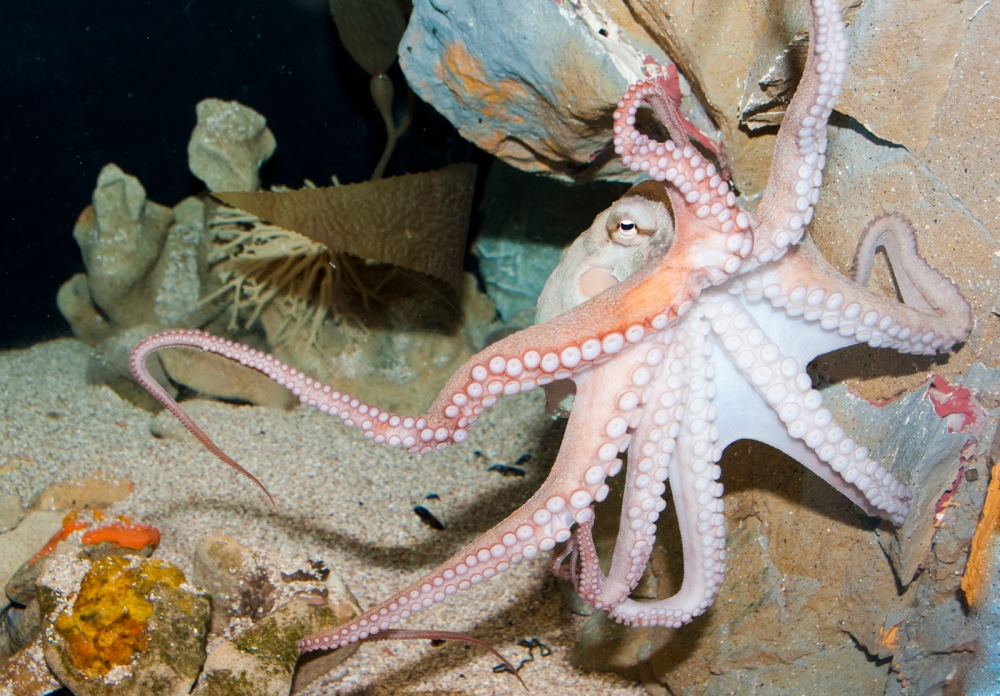Sydney Aquarium currently houses the world’s most venomous octopus – the blue ringed octopus.
There are thought to be four species of Blue ringed octopus, three of which are found in Australian waters. The octopus on display is Hapalochlaena fasciata, and occurs in shallow waters from southern Queensland to southern New South Wales. This species can be found in Sydney harbour. Blue ringed octopus can be found amongst rocks, crevices and rockpools of sheltered inshore areas. They occupy the intertidal zone down to depths of 30 meters.
Blue ringed octopuses are a mottled yellowish-brown colour with dark brown bands and irregular faint blue circles and lines across the body. When threatened, these lines and rings become a vibrant blue colour.
Blue ringed octopuses are very small – rarely exceeding 15cm across outspread tentacles, and have a very short lifecycle. They reach maturity at four months of age, and generally live for only 1-1.5 years.
Blue ringed octopuses are very shy and are masters of camouflage. They generally will be found in small crevices, in shells, and underneath rocks in loose sand and rubble. They are able to change the colour and texture of their skin to match their surrounding environment exactly. This makes this animal extremely hard to find in the wild, and quite hard to spot on display here at the aquarium sometimes!
Venom
Blue ringed octopuses have powerful venom used for defense and for capturing prey. They feed primarily on small crabs, and occasionally on small fish and shrimp. The mouth of the octopus contains a beak like jaw. Prey is bitten, and the venom enters the wound as saliva, rather than being injected. The venom can also be released into the water around the prey item, paralyzing the prey.
The venom contains a neurotoxin called tetrodotoxin. This toxin is also found in other animals such as puffer fish, poison arrow frogs, some newts and salamanders, but the blue ringed octopus is the only animal that uses it in the form of venom. Tetrodotoxin is produced by bacteria that live in the salivary glands of the blue ringed octopus.
Tetrodotoxin shuts down signaling in nerves. The toxin interferes with the signals travelling from the brain to the muscles of the diaphragm and the chest wall and leads to respiratory failure. There is little or no effect of tetrodotoxin on the heart or brain.
One bite from a blue ringed octopus reportedly contains enough venom to kill 26 adult people!
Symptoms
People that have been bitten by a blue ringed octopus will feel numbness or tingling around the face and neck within a few minutes. This may be followed by difficulty in seeing, speaking and breathing. Victims may also experience vomiting, abdominal pain, weakness and lack of coordination. This progresses to paralysis which may last from four to twelve hours. If EAR (expired air resuscitation) is not given when breathing difficulty and paralysis begin, the victim will fall unconscious and die from a lack of oxygen to the brain. Death can occur within thirty minutes.
The victim may be completely paralysed and unable to respond, sometimes with fixed dilated pupils, but may still be aware of their surroundings, and have reported that they have been able to hear everything around them.
The symptoms can vary in severity, with children being most at risk because of their small body size. If the victim lives through the first 24 hours they generally go on to make a full recovery with no lasting side effects.
First Aid
Immediately apply a pressure immobilization bandage to the area of the bite. The bite is often painless and may go unnoticed by the victim. Reassure the victim, monitor their breathing and transport the victim to a hospital immediately. Perform mouth to mouth resuscitation if their breathing stops and continue until medical assistance is found. There is no antivenom available for tetrodotoxin.
Safety
The blue ringed octopus is the most venomous octopus in the world. It is a shy animal that only attacks when provoked. It is often found hiding in seashells and in rockpools. If one is found do not attempt to touch or move the animal.
To see our blue ringed octopus here at Sydney Aquarium, look for the wall tanks on the left-hand side, immediately after the Shark Nursery exhibit (formerly the Sydney Harbour tank).
🙂


